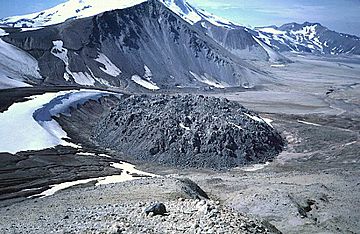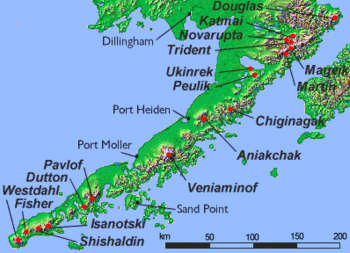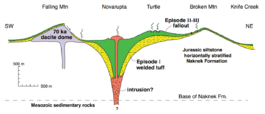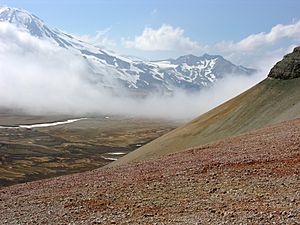Novarupta facts for kids
Quick facts for kids Novarupta |
|
|---|---|

Novarupta's lava dome in July 1987
|
|
| Highest point | |
| Elevation | 2,759 ft (841 m) |
| Geography | |

Map showing volcanoes of the Alaska Peninsula, with Novarupta towards the northeast
|
|
| Country | United States |
| State | Alaska |
| Parent range | Aleutian Range |
| Protected area | Katmai National Park and Preserve |
| Topo map | USGS Mount Katmai B-4 |
| Geology | |
| Mountain type | Caldera with lava dome |
| Volcanic arc/belt | Aleutian Arc |
| Last eruption | June to October 1912 |
Novarupta is a special volcano in Alaska. Its name means "newly erupted" in Latin. This volcano was formed in 1912 during a huge eruption. It sits on the Alaska Peninsula, near another volcano called Trident Volcano.
Novarupta is part of Katmai National Park and Preserve. It is about 290 miles (470 km) southwest of Anchorage. The eruption that created Novarupta was the biggest of the 20th century. It released 30 times more molten rock, called magma, than the famous 1980 eruption of Mount St. Helens.
Contents
The Big Eruption of 1912
| 1912 eruption of Novarupta | |
|---|---|
| Volcano | Novarupta |
| Type | Ultra Plinian |
| Location | Aleutian Range, Alaska 58°16′0″N 155°9′24″W / 58.26667°N 155.15667°W |
| VEI | 6 |
The 1912 eruption that formed Novarupta was truly massive. It began on June 6, 1912, and included many powerful explosions. This eruption lasted for 60 hours, which is two and a half days!
Scientists use a scale called the Volcanic Explosivity Index (VEI) to measure how big eruptions are. The Novarupta eruption was a VEI 6. This means it was very powerful. It blasted out about 13 to 15 cubic kilometers of ash. That's 30 times more ash than the 1980 eruption of Mount St. Helens!
The molten rock, or magma, that came out was made of different types of rock like rhyolite, dacite, and andesite. This eruption created over 17 cubic kilometers of ash that fell from the sky. It also produced about 11 cubic kilometers of hot, fast-moving ash clouds called pyroclastic ash-flow tuff.
Only a few other eruptions in the 20th century were as big. The 1991 eruption of Mount Pinatubo in the Philippines was similar. The 1902 eruption of Santa María in Guatemala was also very large. Even bigger eruptions happened in the 1800s. These include the 1815 eruption of Mount Tambora and the 1883 eruption of Krakatoa.
The Novarupta eruption happened about 6.59 miles (10.6 km) from the top of Mount Katmai Volcano. It was also about 4,000 feet (1,200 meters) below Mount Katmai's peak. As a lot of magma erupted from under Mount Katmai, the ground above it collapsed. This created a huge, bowl-shaped hole called a caldera. This caldera is about 2 kilometers (1.2 miles) wide and 600 meters (2,000 feet) deep.
The eruption finished when a dome of hardened lava, called a lava dome, pushed out. This dome, made of rhyolite, plugged the volcano's opening. This dome is what we now call Novarupta. It is about 295 feet (90 meters) high and 1,180 feet (360 meters) wide.
Even though the eruption was huge, no one died directly from it. People living nearby saw the sky get very dark from the thick ash cloud. The ash could have made their drinking water unsafe and ruined their food. But the Native Alaskans survived by using old knowledge passed down from their ancestors. However, some villages with the heaviest ashfall had to be left behind, and the people moved to new homes.
The Valley of Ten Thousand Smokes
The eruption created hot, fast-moving clouds of ash and gas called pyroclastic flows. These flows filled a valley, which was later named the Valley of Ten Thousand Smokes. A botanist named Robert Fiske Griggs explored the area in 1916. He worked for the National Geographic Society and gave the valley its famous name.
The eruption that formed this valley is one of the few in history to create "welded tuff." This is rock formed from hot ash that fuses together. It also created many fumaroles. Fumaroles are vents in the ground that release steam and gases. These fumaroles kept steaming for 15 years after the eruption!
Katmai National Park and Preserve
Katmai National Park and Preserve was created in 1980. It is located on the Alaska Peninsula, across from Kodiak Island. The park's main office is in King Salmon, about 290 miles (470 km) southwest of Anchorage.
The area was first made a National Monument in 1918. This was to protect the land around the 1912 Novarupta eruption. It also protected the Valley of Ten Thousand Smokes. This valley is about 40 square miles (100 km2) in size and 100 to 700 feet (30 to 210 meters) deep.
See also
 In Spanish: Novarupta para niños
In Spanish: Novarupta para niños
- List of volcanoes in the United States
- Timeline of volcanism on Earth
- Parícutin, a volcano in Mexico that people watched form from the beginning.



